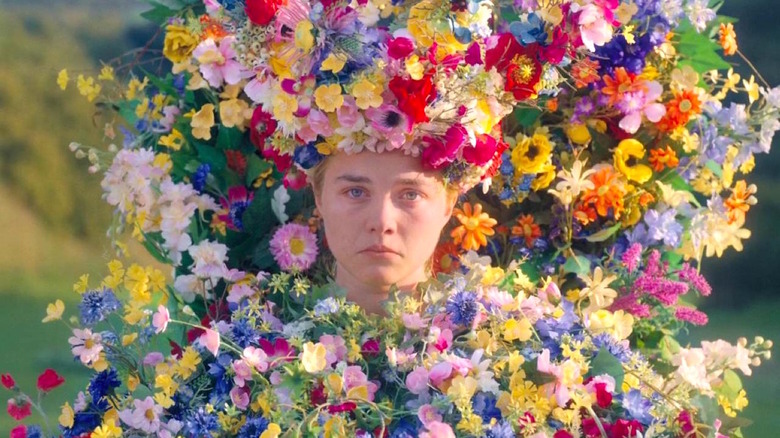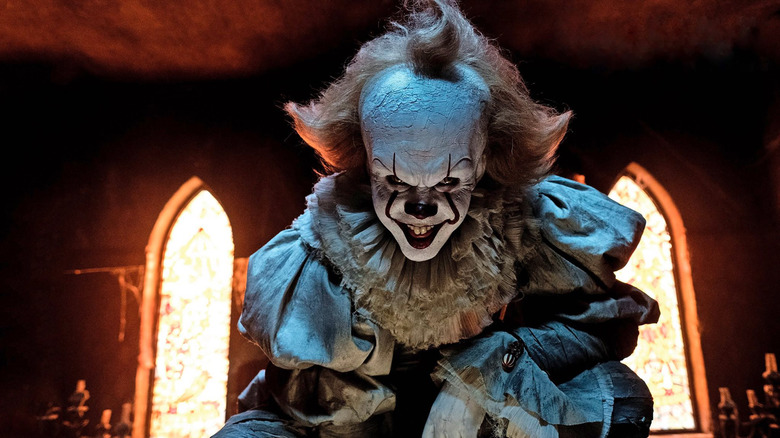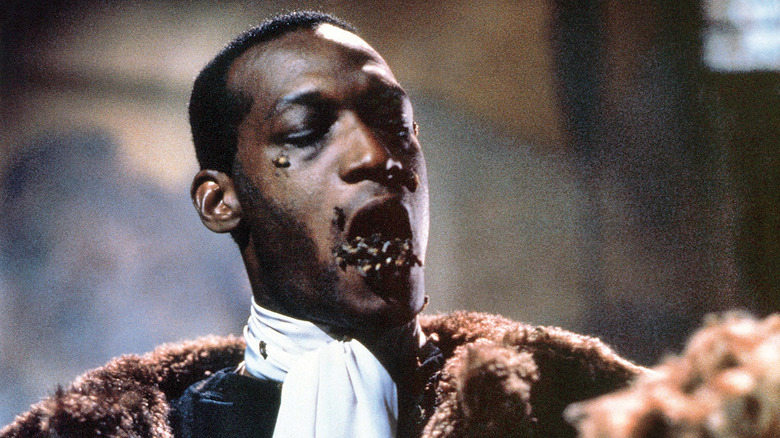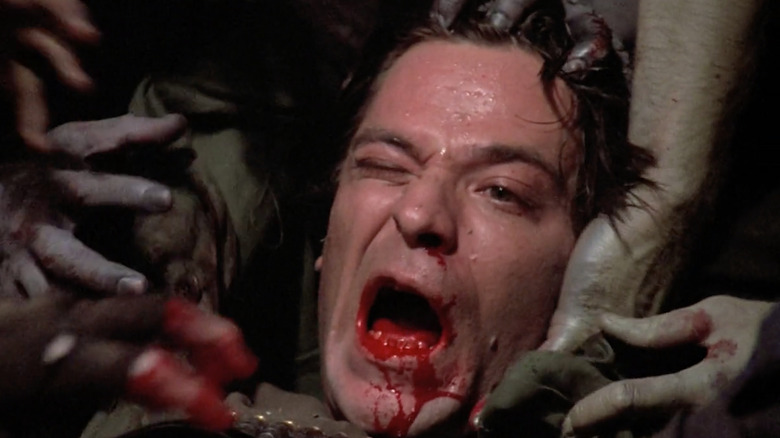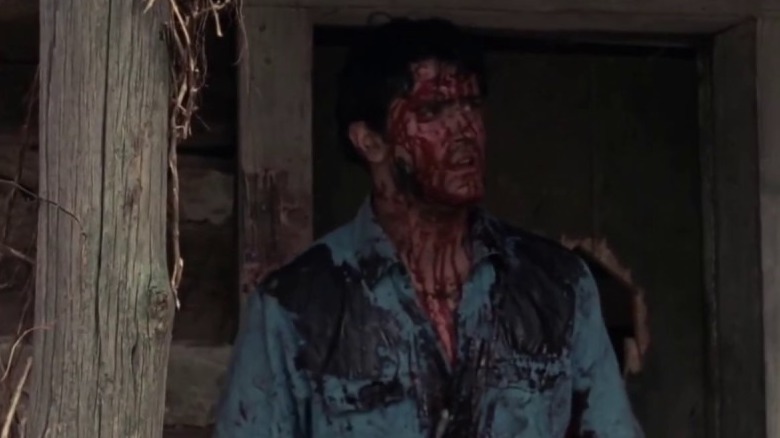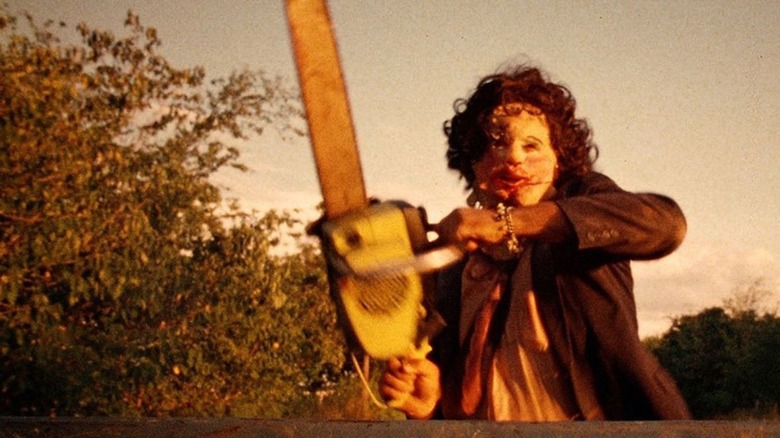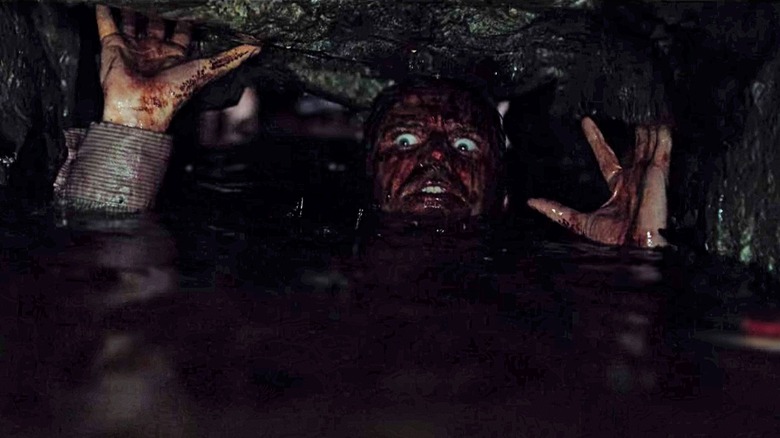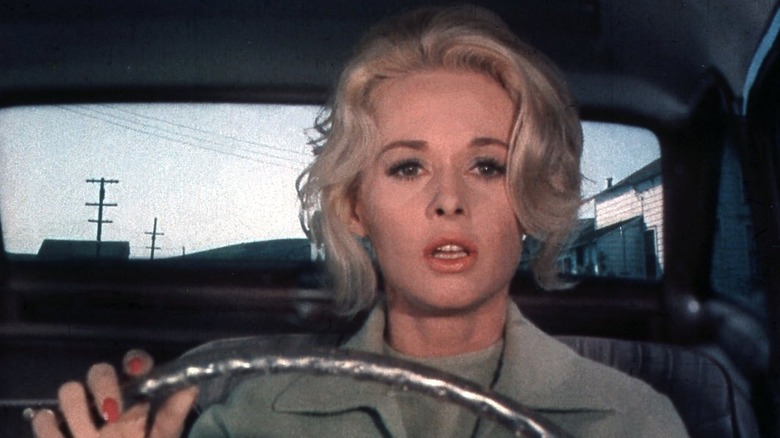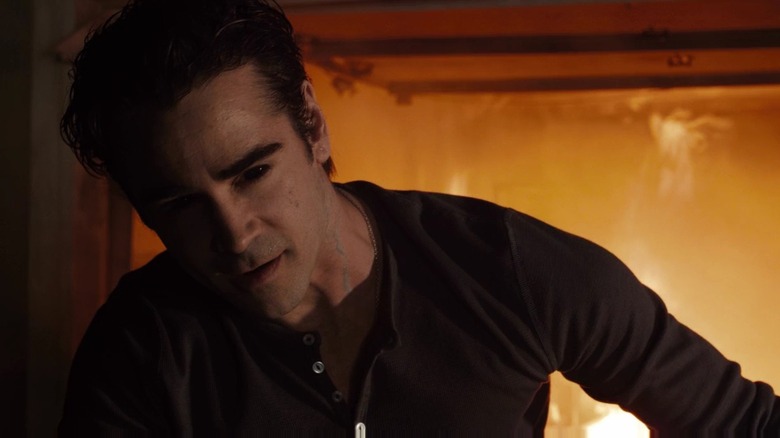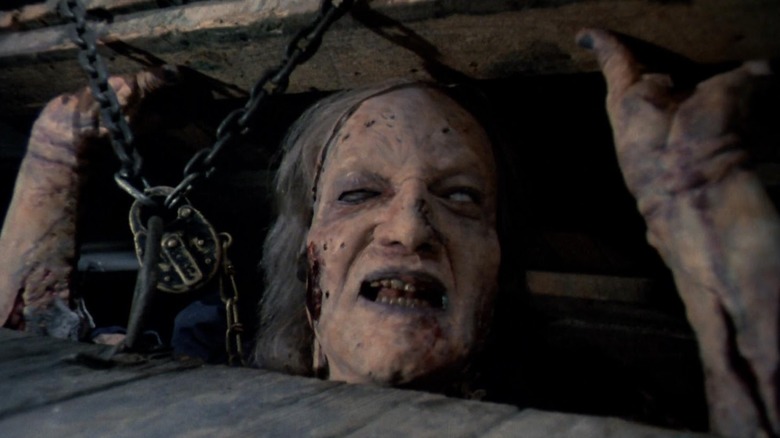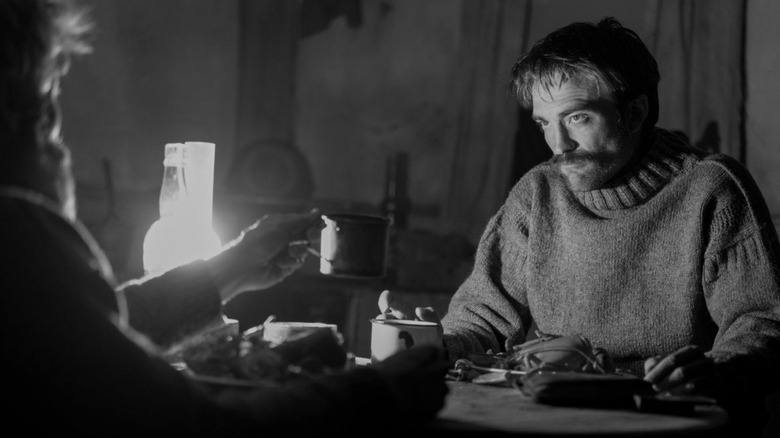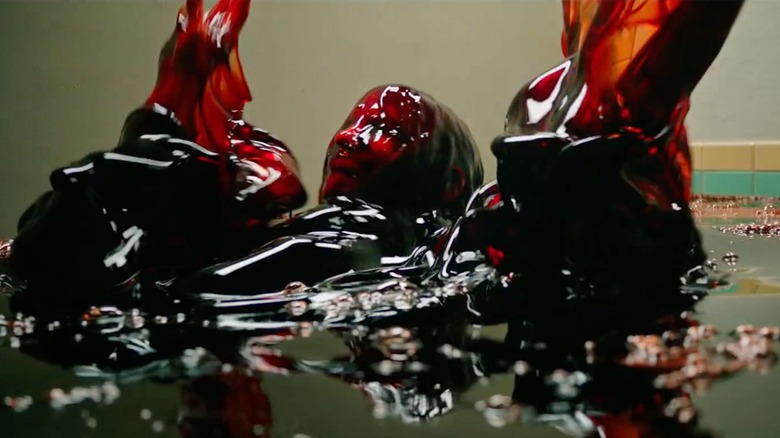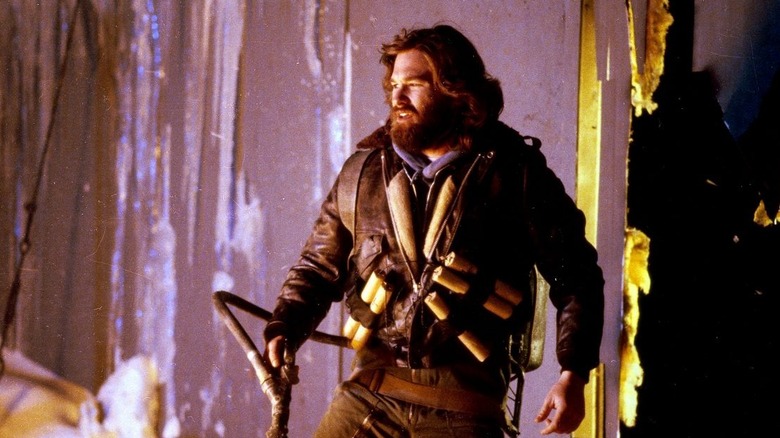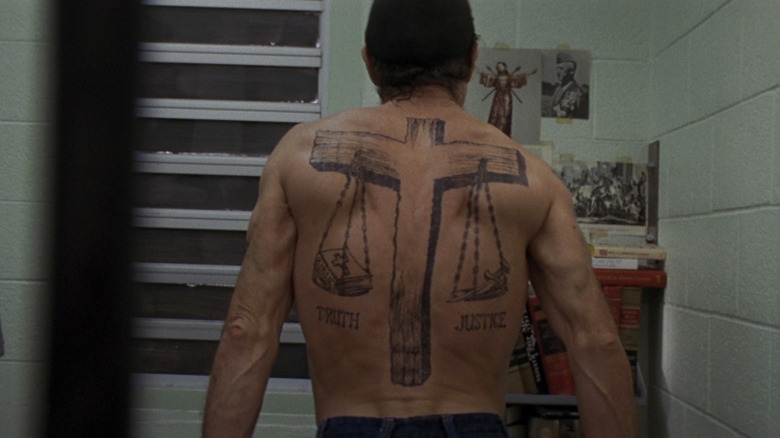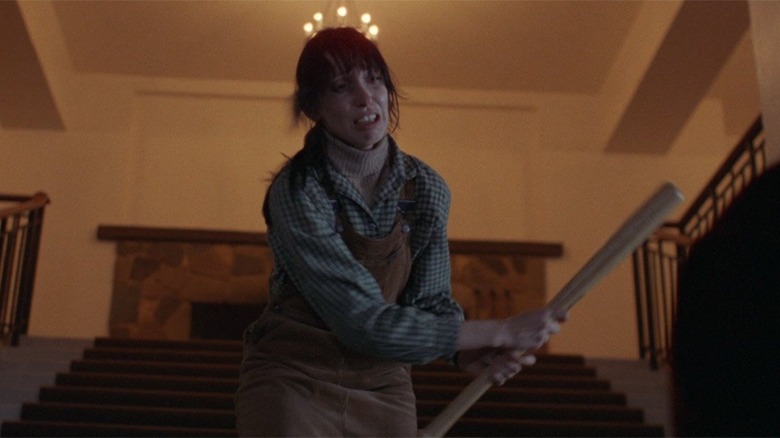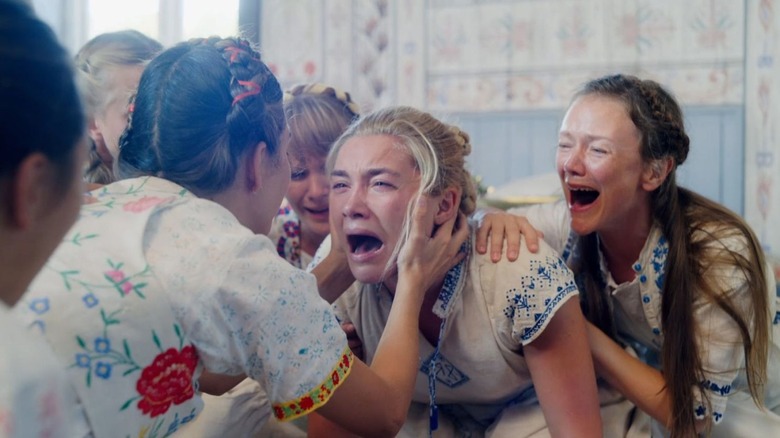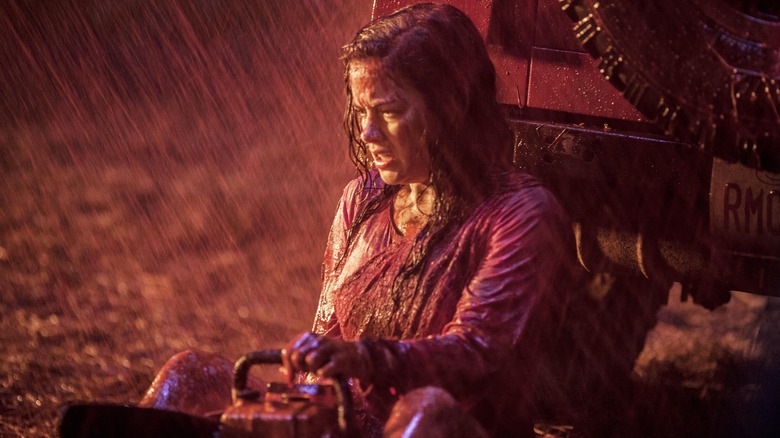The 16 Worst Things Actors Had To Do For Horror Movies
Anyone who says making movies is easy is a liar.
Film sets are tough places. Everyone has a very specific job and never enough time to do it. Budgets are usually tight. Filmmaking equipment doesn't always like to behave. Actors are asked to strip their souls bare while surrounded by an entire crew. There is no such thing as a truly breezy film shoot.
So what happens when you add gallons of fake blood, performers buried in complex monster costumes, and an artistic desire to create something scary and upsetting? You get horror filmmaking, baby.
Every film set has stories of things going wrong or going unpleasantly, but the ones from horror sets tend to grab the imagination firmly between two hands and squeeze until its skull cracks and its eyeballs bulge. And because horror fans (perhaps more than any other fan base) like to know how the bloody sausage gets made, stories of what actors had to endure while making classic and not-so-classic horror movies tend to endure, ready to be told and retold, ad infinitum.
So, without further ado, here are some of the worst or most difficult things actors had to do for horror movies.
Bill Skarsgard Was Forced to Scare Kids for It
Bill Skarsgård did an excellent job bringing Pennywise the Dancing Clown to life in Andy Muschietti's "It," and made fans of Tim Curry's iconic performance proud. That said, he also potentially scarred some kids for life and had a tough time dealing with that.
In a 2017 interview with ... well, Interview Magazine, Skarsgård talked about the experience of terrifying small children as part of his job. "It's a really weird thing," he said, "'If I succeed at doing what I'm trying to do with this character, I'll traumatize kids.'" For the most part, as long as he was on set and suited up, ready to go, Skarsgård tried to stay in character. Then, one day, they were filming a scene with all these child extras who hadn't seen him yet. Accompanied by their parents, no less.
"Some of them were really intrigued," he said, "but some couldn't look at me, and some were shaking." He continued, adding:
"This one kid started crying. He started to cry and the director yelled, 'Action!' And when they say 'action,' I am completely in character. So some of these kids got terrified and started to cry in the middle of the take, and then I realized, "Holy s***. What am I doing? What is this? This is horrible."
All in a day's work, I suppose. (Ariel Fisher)
Tony Todd vs Very Real Bees in Candyman
Actor Tony Todd is a horror legend for several reasons, but there's nothing quite like his performance as the creepy and classic villain in 1992's horror epic "Candyman." That being said, Todd had to deal with some hazardous conditions with bees (Candyman's signature) while shooting the film — from which he was able to make a sizable buck.
"I negotiated a bonus of $1,000 for every sting during the bee scene," Todd told The Guardian in 2019. "And I got stung 23 times. Everything that's worth making has to involve some sort of pain. Once I realized it was an important part of who Candyman was, I embraced it. It was like putting on a beautiful coat."
That insane number of stings means Todd walked away from the "Candyman" set — where he was often covered in bees on his face and even in his mouth — with a $23,000 bonus. Not too shabby for the star, but probably still less than that performance was worth. If you've seen it, you know it was a masterpiece. (Lex Briscuso)
The Most Miserable Zombie Kill of All in Day of the Dead
Captain Rhodes is one of the great villains in George Romero's zombie movies — a violent and unhinged example of human rage unshackled from civilization. He deserves his brutal, iconic death scene, where a crowd of the undead literally tear him in half and feast on his guts. But actor Joseph Pilato certainly didn't deserve what went down during the making of the scene. The pig and chicken guts used to create Rhodes' innards and organs were stored in a refrigerator ... a refrigerator that was accidentally left unplugged, with the animal parts left to bake in the Florida sun for weeks. When someone finally noticed, it was too late. They had to shoot.
During the many hours it took to stage the scene, many crew members were able to keep their distance or at least wear a mask (although many felt physically ill while shooting the scene). But Pilato? The poor actor had to endure being literally covered in rotten animal pieces, under hot film set lights. Before his death in 2019, he claimed he could "still smell them to this day." Knowing this makes Pilato's performance, where he famously yells for the zombies to "Choke on 'em!" as they devour his intestines, all the more impressive. (Jacob Hall)
Every Moment Bruce Campbell Spent Making The Evil Dead
Sam Raimi's "The Evil Dead" may be a low-budget horror masterpiece, but making the O.G. cabin in the woods monster movie was no picnic. Raimi and long-time collaborators Rob Tapert and Bruce Campbell set out to make a new experience in terror, maxing out credit cards, begging relatives for financing, and shooting their movie in a ramshackle cabin in the middle of the Tennesee wilderness. Crew members and actors kept quitting. Money kept running out. The cabin had no running water or heat. With all of that, it was pretty easy to look exhausted for the camera.
In an interview with The Columbus Dispatch, Campbell was pretty blunt about the experience:
"From the beginning to the end — they were all low points. You were in a cabin that had not been occupied in decades, and had no power (or) running water; no sewage; no nothing. It was kind of like camping out for 12 weeks, but meanwhile you're trying to do a movie. There wasn't much acting required: You were cold, you were miserable, you were covered in blood. Some actors have to run around in circles, do push-ups, slap yourself in the face to get ready. We were miserable all day long; we were good to go."
Movie fans may argue it was worth it, but we can't say we'd be in a rush to go through that. (Danielle Ryan)
Gunnar Hansen's Extremely Filthy Time Making The Texas Chain Saw Massacre
Gunnar Hansen has cemented his place in cinema history for bringing Leatherface to life in Tobe Hooper's horror masterpiece "The Texas Chain Saw Massacre." As is often the case, Hansen was an artist who suffered for his art, even if he didn't set out to be the suffering artist type. The movie was filmed in Texas in the summer in the midst of sweltering heat. It was also made on a shoestring budget, so the cast all wore the same clothes each day during filming. In Hansen's case, that meant a whole lot of sweat collecting in all those clothes — and that mask — during the production. Speaking to Yankee Magazine in 1987, Hansen recalled "Sometimes shooting sessions dragged on for more than 26 hours. Since we all had only one set of clothes for the movie, it was too much of a risk to get them washed; the colors might change."
With that, being in close proximity to the other cast members became challenging because, as one can imagine, things got smelly. "After a few weeks of shooting, it was a little more than 'fright' that made us keep our distance from each other," Hansen recalled. But all of that sweat and suffering etched them into the pages of horror history. (Ryan Scott)
Dan Stevens Versus Bananas in Apostle
Actual blood and gore is rather unhygienic and tends to hold up poorly on long filming days. For this reason and a few others, film productions generally avoid using the real thing and instead opt for substitutes like corn syrup and — in the case of Netflix's 2018 horror movie "Apostle" — mashed-up bananas. "Someone would come on with a giant paint brush in between takes and just slather on another layer. And off we go!" star Dan Stevens recalled in an interview with Vulture – creating a mental image that is arguably even more gross than him being covered in real viscera.
Director Gareth Evans went all-out with the blood and gore in "Apostle," including a scene where Stevens' character loses several fingers to a meat grinder before grappling with his basket-headed would-be executioner. The sequence took three days to film and, since the on-camera gore was made from mushy bananas, Stevens told Vulture that over time it "really started to hum [British slang meaning 'stink'] and the vileness of the scene amped up."
Being smeared in smelly mashed-up bananas was actually a high point of the "Apostle" shoot for Stevens, at least compared to a scene where he had to swim through the drainage ditch of a slaughterhouse — the "offal trough," as he refers to it. "You know, it gets pretty cold in Wales," said Stevens. "And some of that water was not heated, but the banana was nice and warm." (Hannah Shaw-Williams)
Tippi Hedren Surviving Alfred Hitchcock While Filming The Birds
"The Birds" is one of the most rightfully famous horror movies of all time, but the story of how it was made is a horror story unto itself. Filmmaker Alfred Hitchcock was a notorious prankster at best and an abuser at worst, and he firmly set his sights on star Tippi Hedren while filming this tale of nature gone amuck. In addition to dealing with Hitchcock's vague direction ("Because I tell you to" was her motivation for one scene, apparently), she endured genuine physical trauma while filming the movie's climax.
Despite being told fake bird props would be used for the finale, the actual shoot involved live birds being literally thrown at Hedren by crew members. Hedren endured this torment for five long days, until one bird sliced her face (barely missing her eye), leading the actress to collapse and break down in tears. Only a doctor's order for immediate rest saved her from additional torment, even as Hitchock himself pushed back against the doctor. "Are you trying to kill her?" the doctor reportedly asked. And from the sound of things, that could have very well been the case. (Jacob Hall)
Colin Farrell Nearly Choking on a Blood Geyser for Fright Night
2011 saw the remake of the 1985 vampire classic, "Fright Night" with Colin Farrell stepping into the role as the seductive and dangerous vampire, Jerry Dandridge. Vampire movies are known to be bloody, and this remake is no exception. However, as the bloopers of "Fright Night" would showcase, Colin Farrell had a bit of a rough time with one of the blood gags on set. Farrell's Dandridge attacks an unsuspecting victim played by Christopher Sarandon, the original Jerry Dandridge in 1985's "Fright Night," in a cameo role.
During the scene, however, the tubing rigged on Sarandon to squirt blood worked a little too well, and shot high-pressure fake blood directly into Farrell's throat. The crew heard what they thought was the rigging making a terrible gurgling sound, but in actuality, the sound they heard was Farrell choking on the blood and desperately trying to push air through his mouth to breathe as it filled with bloody liquid. Thankfully, he was okay and able to laugh about the incident after the fact, and "Fright Night" fans were gifted a killer scene between the two Dandridges. (BJ Colangelo)
Ted Raimi Sweating Literal Gallons While Making Evil Dead 2
Imagine being encased by latex, in North Carolina's heat, for multiple hours a day on a film set where high-powered lights and other production elements increase temperatures. That was Ted Raimi's curse during his scenes as Henrietta in Sam Raimi's "Evil Dead II," where he played a historian's demonically-possessed wife. Ted's body sweated literal buckets of salty runoff into the deadite's full-body costume, which was reported to collect liters' worth of bodily liquid. Don't believe me? Watch carefully when Henrietta spins around over Annie's head, and you'll see perspiration dripping out of the monster's ear and info frame.
You have to wonder what childhood abuse Ted inflicted unto Sam Raimi, his brother and director, that would justify such torment. Or you could outright award Ted a "Brother Of The Year" trophy for broiling day after day just to give Sam the perfect take. At least special effects guru Gregory Nicotero was reportedly available to pour Ted's sweat into Dixie cups, so the actor wasn't sloshing around in his self-produced stanky stew. (Matt Donato)
Robert Pattinson Doing the Most to Get Into Character in The Lighthouse
Willem Dafoe had to run lines with a mouth full of dirt while shooting Robert Eggers' "The Lighthouse," but it seems that Robert Pattinson may have had it a touch worse to get into character as Ephraim Winslow. In a 2019 interview with Esquire, Pattinson said because he was playing "a mad person, it means you can sort of be mad the whole time. Well, not the whole time, but for like an hour before the scene."
Pray tell, Esquire, what does he mean by this? Well, dear reader, according to this interview, in his scenes where he's supposed to be drunk on kerosene, Pattinson said he was "basically unconscious the whole time."
"It was crazy," he continued. "I spent so much time making myself throw up. Pissing my pants. It's the most revolting thing. I don't know, maybe it's really annoying."
Not so sure I'd describe that as "annoying," per se, but revolting sounds about right. That said, it seems the majority of his Method approach is a reaction to the pressure of his early immense fame. He explained:
"For a long time you're very self-conscious in the street. You're hiding a lot, so [on set] you have an excuse to be wild. It's like being an adrenaline junkie. And also, when you don't know how to do something, why not just run headfirst into a wall? See what happens. I haven't got any other ideas."
Some of his ideas on "The Lighthouse" included all of the above, as well as spinning in circles to throw himself off balance, and putting a rock in one of his shoes. None of that holds a candle to the discomfort of rehearsals, however. Or long walks by the sea. Dafoe interviewed Pattinson for Interview Magazine, asking him "Do you remember when we were being sprayed with that water and it stung so bad?" "That's the closest I've come to punching a director," Pattinson replied:
"However much I love Robert [Eggers], there was a point where I did five takes walking across the beach, and after a while I was like, 'What the f*** is going on? I feel like you're just spraying a fire hose in my face.' And he was like, 'I am spraying a fire hose in your face.' It was like some kind of torture. It definitely creates an interesting energy. [Laughs]"
(Ariel Fisher)
Jessica Chastain Versus a Blood Pool for IT Chapter Two
While "IT Chapter Two" might not be as roundly beloved as its predecessor, an increased budget allowed them to go bigger with some key sequences. Namely, a scene in which adult Beverly, played by Jessica Chastain, gets covered by 4,500 gallons of blood near the film's climax in what is one of the bloodiest scenes ever put to film. Fitting that such an honor belongs to a Stephen King movie. The scene in question takes place as Pennywise is making the Losers face their biggest fears, and Bev winds up submerged in blood in a bathroom, which Chastain actually had to do for hours on end.
It wasn't cake for the filmmakers either, as filming the scene was complex and required the construction of three interconnected sets to make it work, logistically. Chastain, speaking to Vanity Fair, said "It was really disgusting." She added, "It's like slime, and it was up my nose, in my ears, and stuck on my eyeballs. I kind of did have some little fears." But she also said she was "happy to do it." Commitment. (Ryan Scott)
A Set That Became a Literal Refrigerator for The Thing
John Carpenter's "The Thing" is one of the chilliest cold-weather flicks in the horror genre, and that's due to temperature authenticity. Alaska and British Columbia represent the frigid exterior shots of research facilities, but indoor settings took Carpenter's production back to Los Angeles' 100-degree heat waves. There was a brief consideration to film in refrigerated units — think gigantic meat lockers — but their walls and ceilings didn't provide enough space. Instead, the team amassed as many portable air conditioners as possible and closed off the stage so that temperatures would dip below thirty degrees Fahrenheit. Actors didn't need to pretend their characters are frozen to the bone because they're legitimately shivering under costume warmth.
Carpenter called upon movie magic to counter California's blazing rays with a manufactured tundra that surely pleased everyone present for shooting each day. It's a good thing Kurt Russell took that year to grow out his bushy beard and insulating hairstyle, for more reasons than his character's iconic look. (Matt Donato)
Robert DeNiro Getting Vegetable Ink Tattoos for Cape Fear
It's not easy to apply fake tattoos that will stand up to the punishment of filming without becoming smeared or faded. But Robert De Niro felt that his tattoos in Martin Scorsese's 1991 thriller "Cape Fear" were so important to the character of Max Cady that he was willing to go the extra mile in order to make them look good. De Niro was tattooed with vegetable dyes, which had to be touched up during filming but otherwise remained on his body for several months before the organic ink was eventually broken down.
According to a blog post by Temptu, the make-up company behind the tattoos, their application took an hour and a half and "De Niro got so deep into character that we had to actually increase the size of the tattoos about 10% due to the additional muscle he had gained."
Not all of De Niro's tattoos in "Cape Fear" were fake, though. The black panther tattoo seen on his right bicep is real, and can also be spotted in Scorsese's 1973 film "Mean Streets." (Hannah Shaw-Williams)
Shelley Duvall Suffering Stanley Kubrick to Make The Shining
In the years since the release of "The Shining," much has been revealed about the horrendous working conditions for all the cast and crew of the film, but none were as extensive or as exhausting as what happened with actress Shelley Duvall. In an attempt to get a more "authentic" performance from Duvall, director Stanley Kubrick unexpectedly cut her lines to throw her off, kept her isolated and waiting for long periods of time between scenes, criticized every choice or acting impulse she had for Wendy Torrance, and ordered the crew to follow suit, even being quoted in the documentary "Stanley Kubrick: A Life in Pictures" as directing crew members "Don't sympathize with Shelley."
Kubrick hit peak viciousness during one of the most iconic scenes of "The Shining," the baseball bat confrontation on the stairs, where Kubrick shot the scene with a world-record setting 127 takes. The skin on Duvall's hands was shredded raw from gripping the bat, and she cried herself hoarse and became dehydrated. She was so stressed her hair began falling out. Shelly Duvall's portrayal of Wendy Torrance made her a horror legend, but it's a performance that came at the expense of her mental and physical well-being. (BJ Colangelo)
Florence Pugh Enduring a Very Real Breakdown on Midsommar
Florence Pugh made herself known to the world through her impressive and haunting performance in Ari Aster's sophomore feature, "Midsommar" — and she really left her emotions onscreen while shooting. In March 2021, Pugh revealed via Instagram that she went through an incredibly difficult shooting process alongside the various Hargan women with whom she shot that intense crying scene. She wrote:
"Truly, these women made this scene possible. It was TERRIFYING. As terrifying as it was to watch, it was to read and know we had to do it. I love these girls so much. I'm not a big crier, so going through that with them was true safely and love and respect. It only happened because I had them. We all looked at each other before we started rolling and knew it would be hard. And awkward. And strange. And unnatural. We knew it wouldn't be pleasurable. But by the end we would roll in each other's laps and cry and allow our bodies to keep heaving. I remember the first take being so long, much longer than is displayed in the film that you all watched. When Ari said cut, we all clung on to each other's arms and dug our nails into each other's palms and wept. Sobbed. Heaved. I remember it being really hard to stop."
It's clear the emotional output paid off in spades — but there's no doubt that kind of traumatic reenactment can mess around with your psyche. (Lex Briscuso)
Jane Levy Getting Buried Alive in the Evil Dead Remake
Maybe difficult shoots are just a part of the "Evil Dead" backbone, because the star of Fede Alvarez's 2013 remake, Jane Levy, endured physical and psychological torture to bring her character Mia to life. She told Yahoo! Movies that the hardest part was being buried alive; she had a plastic bag around her head with an oxygen tube behind her ear. Sometimes she would lose air and have to dig herself out. "That was a hard day," she said. No kidding.
Other things Levy had to do? Pretend to cut her tongue in half, vomit on someone's face, fall down a hill, crawl through a swamp, crash a car, rip her own arm off, and get assaulted by a demon tree. By the end of filming, which was mostly shot chronologically, Levy had "nothing left." The actress has been candid about not really wanting to return to the franchise, so it's no surprise she's not a part of the upcoming "Evil Dead Rise." (Danielle Ryan)
